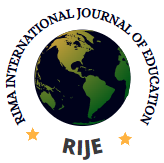Evaluating the Effectiveness of Mobile Technologies on the Teaching and Learning Process in Usmanu Danfodiyo University, Sokoto
Mustapha A. Isah. & Aminu Kabiru
1*Department of Curriculum Study and Educational Technology, Usmanu Danfodiyo University, Sokoto, Nigeria.
2Department of Science Education, Sokoto State University, Sokoto, Nigeria.
Abstract
Using information technologies for improving the teaching and learning process is becoming popular, thanks to its countless benefits such as assessing learning content anytime and anywhere, adjusting the content to students’ needs and timely feedback. The purpose of this pilot study is to Evaluating the Effectiveness of Mobile Technologies on the Teaching and Learning Process in Usmanu Danfodiyo University, Sokoto. The methodology is a descriptive survey research in nature which assesses whether both the lecturers and students are technologically and psychologically ready for the use of mobile technologies in education. The population of the study consist of 50 lecturers and 150 students were selected through simple random sampling technique. The instrument for this study was constructed by the researcher and validated by two experts from Usmanu Danfodiyo University, Sokoto. The questionnaire is known as Mobile Technologies Improvement Needs (MTIN). The questionnaire was developed to collect the data from lecturers and students. The questionnaire items were sub-divided into three sections ‘A’, ‘B’, and C’, then each section comprised of 15 items which were graded on five point of: Strongly Agree (SA)-5 Agree (A)-4 (UNC)-3 Disagree (D)-2 Strongly Disagree (SD)1. Data were analyzed using mean score for calculated overall level of agreement / disagreement for each statement. For mean score norm was 3.00. However, level of agreement was different for each statement. The data was also analyzed percentage with the help of Statistical Package for Social Science (SPSS 22.0 version). A narrative approach and quantitative tools such as frequency tables and percentages were used to arrange and present the result. The findings of the study revealed that majority of lecturers and students used mobile phone technologies to support their teaching and learning. From the data analysis some of the challenges students faced when using mobile phones to support their learning are cost of the phone, battery life and network. In conclusion, lecturer and students will no longer need to be limited to the ability to tech and to learn at a particular place and time in the future. Finally, the researcher recommends some points from the conclusion that a well-resourced mobile learning facility Centre needs to be established within the higher institutions where lecturers and students who lack experience with using mobile technologies will be trained.
Keywords
Mobile Technologies, Process, Teaching and Learning, University
Reference
Adomi, E. E. (2006). Mobile Phone Usage Patterns of Library Mobile Phone Usage Patterns of Library and Information Science Students and Information Science Students
Ally, M. (2004). Using learning theories to design instruction for mobile learning devices.
Almaiah, M.A., Jalil, M.A. & Man, M. (2016). Empirical investigation to explore factors that achieve highquality of mobile learning system based on students’ perspectives. Engineering Science and Technology, an International Journal, 19(3), 1314-1320.
Alnabhan, M., Abu-Al-Aish, A., & Al-Masaeed, S. A. (2018). Collaborative and ubiquitous mobile learningsystem prototype. International Journal of Computer Applications in Technology, 58(4), 296–307. doi:10.1504/IJCAT.2018.095939
Clark, J.D. (2007). Learning and Teaching in the Mobile Learning Environment of the Twenty- college students’ use of communication technologies. Cyber Psychology Behavior, 13(6), 619–627.
Dean, J. (2010). Smartphone User Survey: A Glimpse into the Mobile Lives of College directory.
Friend, B. (2011). Using mobile learning to connect with students. Home educators‟ resource fromhttp://www.mobile_internet_usuage_field_survey_Ghana_Executive_ Summary.pdf.
Gay, L.R., Mills, G.E., & Airasian, P. (2009). Educational Research. Competencies for analysis
Giannakoulas, A., & Xinogalos, S. (2018). A pilot study on the effectiveness and acceptance of an educational game for teaching programming concepts to primary school students. Education and Information Technologies, 23(5), 2029–2052. doi:10.1007/s10639-018-9702-x
Huang, Y-M., Hwang W-Y., & Chang, K. -E. (2014). Innovations in designing mobile learning iHUB Research. (2012). Mobile Internet Usage Field Survey Ghana. Retrieved Improve Teaching and Learning in an African University. The 36th ASEE/IEEE Frontiers in Education Conference.M4C-22. San Diego, CA.
Hsu, T.-Y., Chiou, C.-K., Tseng, J., & Hwang, G.-J. (2016). Development and evaluation of an active learning
support system for context-aware ubiquitous learning. IEEE Transactions on Learning Technologies, 9(1), 37–45. doi:10.1109/TLT.2015.2439683
Kukulska-Hulme, A.(2016) Personalization of Language Learning through Mobile Technologies; Cambridge University Press: Cambridge, UK, 2016. [Google Scholar]
Peachey, N. (2010). Mobile learning for English language teachers. Retrieved from phone use and clinical symptoms in college students: the role of emotional intelligence. C Computers in Human Behavior, 25(5), 1182–1187.
Rezaei, A.; Mai, N.; Pesaranghader, A. The Effect of Mobile Applications on English Vocabulary Acquisition. Available online: https://www.researchgate.net/publication/261246911 (accessed on 12 December 2018).
Sarrab, M., Elbasir, M., & Alnaeli, S. (2016). Towards a quality model of technical aspects for mobile learning services: An empirical investigation. Computers in Human Behavior, 55, 100–112. doi:10.1016/j.chb.2015.09.003
Shuler, C. (2009). Pockets of Potential: Using Mobile Technologies to Promote Children’s Situating learning in everyday experience. In Same places, different spaces. Proceedings asciliteAucklan 2009.Retrieved fromhttp://www.ascilite.org.au/conferences/auckland09/procs/waycott.pd.
Traxler, J. (2005). Defining Mobile Learning. Proceedings IADIS International Conference undergraduate students of Nigerian private universities. International Journal of Education and Development using Information and Communication Technology (IJEDICT), 8(1), 4-15.Retrieved from http://ijedict.dec.uwi.edu/viewarticle.php?id=1357
UNESCO. (2005). Mobile Learning for Expanding Educational Opportunities: Workshop using mobile technologies – Recommendations for the use of m-learning strategies to support disengaged youth in vocational education and training. New Practices in Flexible Learning. Project Report for Supporting Flexible Learning Opportunities – Australian National Training Authority .Retrieved from http://flexiblelearning.net.au.
Virtanen, M. A., Elina Haavisto, E., Eeva Liikanen, E., & Kääriäinen, M. (2018). Ubiquitous learningenvironments in higher education: A scoping literature review. Education and Information Technologies, 23(2),
Wang, H. Y., Liu, G. Z., & Hwang, G. J. (2016). Integrating sociocultural contexts and location based systems for ubiquitous language learning in museums: A state of the art review of 2009–2014. British Journal of Educational Technology, 48(2), 653–671. doi:10.1111/bjet.12424
Wendeson, S., Fatimah, W. Bt., Ahmad, W., & Nazleeni S. Bt. H. (2010). University Student windos: A Guide for Social Scientists. Philadelphia: Taylor and Francis Group.
